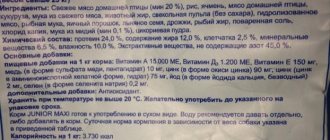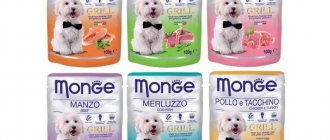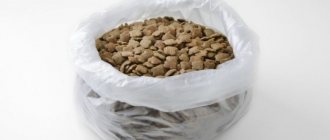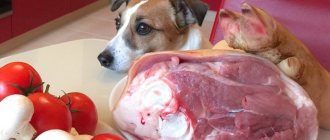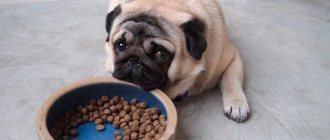Sooner or later, a dog breeder faces the question of whether to feed the dog by-products or only pure meat? Beef kidneys are cheaper than pulp, and is there any point in giving them, even if the budget allows you to feed your pet clean tenderloin?
The answer is clear: yes. Beef kidneys are beneficial for the animal's body. Eating the entire carcass of a caught victim with all its entrails is a traditional food for the ancestors of dogs and predators.
Benefit
Dogs belong to the order of predators. In nature, the ancestors of modern animals killed the victim and ate the entire carcass.
At the moment, the digestive system of dogs is formed in this way: protein foods, raw meat and offal are the most beneficial for them. The latter can be easily purchased at the market or at a butcher shop. It is a valuable source of protein and nutrients.
According to their structure, the kidneys belong to the pulpy by-products of the first category. Their nutritional properties are similar to meat. Feeding them raw allows you to preserve the maximum amount of vitamins: iron, B vitamins, selenium. Calorie content per 100 grams – 86 kcal, proteins – 15 grams.
Kidneys also contain saturated fatty acids, pantothenic acid, vitamins: A, B1, B2, B9, C, D, E, K, PP. Minerals: magnesium, molybdenum, calcium, sodium, zinc, cobalt, potassium, sulfur, iodine, phosphorus, copper.
Is it possible to feed a dog pork?
People often wonder, can dogs eat pork? This article will separate the reality from the fairy tales surrounding this type of meat. But it is worth realizing that at the moment, breeders and veterinarians are just moving away from prejudices about pork; not everyone agrees to take risks when feeding their pets, even based on the required meat parameters, therefore this material only introduces what is already clear, but the controversy surrounding pork last.
When preparing a diet for a pet, in most cases pork is indicated as a terrible fatty food that is contraindicated for dogs. Is this essentially true, is it unsafe for the animal? It will be clear after reading this article, which describes the negative and positive characteristics of this meat.
How to give?
Offal is given 2-3 times a week, or daily, but in smaller portions. Due to the presence of vitamin D, it is especially useful to give them in winter. Kidneys should not occupy more than 15-20 percent of the diet per day.
Sometimes they are given as part of meat porridges, but according to modern research it is believed that it is possible to refuse carbohydrates in the diet or reduce their amount to a minimum.
The opinion that dogs can be fed porridge came from the USSR from service dog breeding. In those days, it was necessary to feed service dogs as cheaply as possible; the pets worked extremely hard and, unfortunately, on such food their life expectancy did not exceed 5 years. At the moment, this approach to nutrition is not relevant.
Is it possible raw?
Of course, it is the kidneys that can be given raw without fear. Some still boil all the by-products just in case, but then you should understand that a lot of vitamins are lost.
What should I feed?
At the market or in a store, the seller must have all the necessary documents for raw meat and seals. High-quality beef kidneys should be whole and without damage. They are cut with grooves and weigh 500-1000 grams.
The color is red-brown brownish, uniform, the surface is shiny and there are no bruises. After purchasing, they should be cooked immediately or fed after soaking. Store unused portion in the freezer.
Is it possible to feed a dog pork?
People often wonder, can dogs eat pork? This article will separate the reality from the fairy tales surrounding this type of meat. But it is worth realizing that at the moment, breeders and veterinarians are just moving away from prejudices about pork; not everyone agrees to take risks when feeding their pets, even based on the required meat parameters, therefore this material only introduces what is already clear, but the controversy surrounding pork last.
When preparing a diet for a pet, in most cases pork is indicated as a terrible fatty food that is contraindicated for dogs. Is this essentially true, is it unsafe for the animal? It will be clear after reading this article, which describes the negative and positive characteristics of this meat.
How to cook?
The raw product contains a certain amount of veins and films, but they must be removed before sale. It is sold already prepared.
Before use, they must be soaked for at least 30 minutes in clean cold water. Used water is drained and not used anywhere. The kidneys are cut into small pieces before feeding.
Recipes
Usually the kidneys are given raw, but if for some reason the owner decides to heat them, then there are special dog recipes. There is no need to prepare a new menu every day.
Depending on the health and tastes of your pet, you can prepare a couple of days ahead and just a few main dishes. Fresh cottage cheese, fish and other healthy products are given at the discretion of the owners in addition to the main diet.
Your pets will love this dinner. The kidneys are boiled a little in water. Then the porridge is cooked in this broth; serve the dish when it has cooled. The bowls usually remain empty after such a delicacy.
Another recipe for serving beef kidneys to your pet is a meat mix . Different types of offal are cut into small pieces. Throw into cold water and cook for 20 minutes. The dish is ready.
Meat porridge . Boil oatmeal and rice with the addition of beef kidneys. You can add zucchini, carrots, apple.
Reference! You should not add salt or spices from your table to your dog’s food.
How long to cook?
Beef kidneys can be given raw. It’s worth soaking them in cold water for half an hour and draining them. If you decide to feed your pet boiled food, then you should not overexpose them for more than 20 minutes.
Fried and stewed
Fried and fatty foods put a tremendous strain on the animal’s liver. Frying any food for dogs is strictly prohibited. Extinguishing is also prohibited. It is better to give food raw or cooked.
Important! Dogs should not eat fried or stewed foods. Foods from the human table, especially chocolate, are prohibited.
Why are bones dangerous for dogs?
First, you need to understand why we give bones to our wards? Of course, in order to sharpen teeth and strengthen them. In reality this is not the case. Think for a moment and the conclusion will become obvious - a dog is not a rodent, not a mouse or a rabbit, and it does not need to sharpen its teeth, since they do not grow longer than they should. That is, the dog does not need to grind down its teeth.
It is logical to assume that bones will be useful for a puppy from three to six months, when the process of replacing baby teeth with permanent ones is in full swing. The animal's gums are itchy and require relieving tension by chewing. Since household items are not suitable for this purpose, sugar seeds do the job best. So the use of bones will be justified only in this case.
A dog's stomach juice is very concentrated and is able to digest hard bones. This is indeed true, but only in an ideally healthy, young and strong dog. Babies, pregnant and lactating bitches, sick, weakened and old dogs have problems digesting any food and loading the body with bones is simply criminal.
Veterinarians are often faced with the problem of a stomach full of undigested bones, which interfere with the passage of food, causing volvulus. Systematic feeding of such a product leads to alternating diarrhea and constipation in the dog. And sharp hard bone fragments pierce the esophagus, stomach and intestines, and in this case urgent surgical assistance is required.
Different breeds
There is no fundamental difference in feeding different breeds of healthy animals. It is necessary to take into account the health status of each individual pet, but there are several general patterns.
Large breeds of dogs, such as German shepherds, are especially beneficial for by-products. Dalmatians should not be fed large amounts of protein. For an adult dog, protein should not exceed 25%, and for a puppy 32% in the diet. In general, kidneys can be fed at one-third of the diet for large breeds and one-half for small breeds.
To give or not
Some dog breeders, especially if they feed their pet dry food, are afraid to let him chew bones. This is not entirely true.
It is recommended that a dog, even the smallest breed, be given a certain load to its jaws.
Of course, you shouldn’t give a tiny toy a huge beef moth, but it’s good to pamper your dog with soft ribs of lamb or kid.
Large and young dogs with strong teeth are given large bones, making sure there are no sharp chips.
Basically, a dog chews a bone for pleasure and entertainment, gnawing off veins and cartilage from it. Only a hungry dog shows interest in a “bare” bone.
Beneficial properties and possible harm
Every owner should know what by-products can be given to a dog. Of the huge variety, only a few have a positive effect on your pet’s health.
Pets will happily consume almost all offal
Benefit
Many people underestimate offal because of its low calorie content. Despite this disadvantage, they contain a large amount of useful substances. Trip is considered a dietary food, so it can be used to feed overweight dogs, as well as during treatment.
The benefits of offal lie in its rich vitamin composition: phosphorus, iodine, iron, potassium, magnesium. They contain folic acid, which is necessary to maintain immunity. The presence of vitamins of different groups is also noted.
Liver, kidneys, tongue, hearts and tripe are the most useful offal
Note! Some owners prefer to give their pet dried food as a reward treat. The liver, ears, snouts, tracheas, veins and scar are dried.
Harm
Despite the benefits, offal can be harmful to the dog. Negative consequences include:
- individual intolerance and allergies. The latter may manifest itself as a rash, diarrhea or vomiting;
- Excessive consumption of liver can cause the appearance of stones in the same organ of the pet. To prevent the occurrence of pathologies, liver in the diet should not make up more than 5%;
- You must be careful when handling raw products. Some organs contain embryos of worms, which, when consumed, begin to develop in the pet’s body;
- Often the cause of diarrhea in animals is excessive consumption of hearts. It should be remembered that heavy protein is poorly digestible.
Nutritional quality of offal
The basis of the carnivore menu is animal protein. In addition to meat, four-legged animals enjoy eating kidneys, lungs and udders. Adding them to food will not only diversify the menu, but will also have a positive effect on the body.
Beneficial features
Offal contains a large percentage of nutrients. In this they are superior to regular meat. All parts of the animal carcass are an irreplaceable source of animal protein, without which the life of a four-legged friend is impossible.
The trim contains the following elements:
- phosphorus
– responsible for oxygen enrichment and skeletal health;
- iron
– regulates oxygen metabolism;
- zinc
– necessary for the functioning of the nervous system and healthy coat;
- potassium
– supports the functioning of the kidneys and heart;
- selenium
– natural antioxidant;
- magnesium
– needed for health and good muscle development;
- iodine
– ensures uninterrupted operation of the endocrine and cardiovascular systems.
Trip is rich in amino acids, vitamins B, A, K, E and D. The latter is necessary to strengthen the pet’s muscles and bones, prevent the development of malignant tumors, rickets and other autoimmune diseases. Giblets have no equal in vitamin D content.
Eating trimmings is especially useful for dogs living in the northern regions. The lack of sunlight and the resulting deficiency of chemical elements is compensated by the addition of tripe.
Giblets are an irreplaceable source of energy for cells, as they contain Omega-3 and Omega-6 amino acids. In addition, liver contains a small proportion of carbohydrates and fats, so it is classified as a dietary product.
Unpleasant consequences
Sometimes a four-legged friend has an individual intolerance to some or all types of tripe, even in small quantities. Such a reaction is expressed in the form of vomiting, diarrhea or food allergies.
A pet suffering from intolerance begins to behave irritably. He becomes lethargic and refuses to eat. A rash characteristic of an allergy appears on the surface of the face, paws, and ears. Sometimes it is visible on the armpits and in the anal area.
An excess of the allergen provokes infections on the skin or ears. The body becomes covered with red itchy spots, and hair loss occurs.
To eliminate the problem, it is enough to exclude allergens in the form of chicken and animal entrails. And in the future, add only lean varieties of meat to the allergy sufferer’s menu.
If it gets bad
Sometimes a pet may become ill after eating beef lung. Most likely reasons:
- The dog has gastrointestinal problems. Due to its porous structure, the treat is more difficult to digest than other foods.
- An error was made during preparation. Before feeding your pet, you need to boil the offal well and then chop it. Whole connective tissue fibers can make your dog feel sick.
- The product was stale.
The main symptoms of a pet feeling unwell after eating lung are vomiting and diarrhea. In case of poisoning, lethargy may occur.
If you notice any of the above symptoms, provide your dog with free access to water, and, if possible, do not give heavy food that is poorly absorbed by the body. If symptoms of lethargy appear, your pet should be taken to a doctor immediately. The veterinarian will provide qualified assistance and prescribe treatment.
Nutritional value
Beef lung is good for dogs if the animal is not allergic to it. Pork and lamb lung can also be cooked for your pet. Lungs belong to the second category of offal, along with lips, legs, ears, spleen, brains, etc.
Belonging to category II means that the nutritional value is low. The bulk of the organ is made up of difficult-to-digest connective tissue. It also contains a lot of proteins, but they are incomplete, that is, they are not absorbed by the body.
Among the beneficial substances, beef lung contains the following:
- iron, calcium, potassium, sodium, magnesium;
- iodine, phosphorus;
- vitamins C and group B;
- sulfur.
This makes lungs a rather valuable food product that is suitable not only for dogs, but even for humans.
There are many recipes for fillings for pies, pancakes, stews, goulash, pates. True, they are quite labor-intensive. But dishes for the dog menu do not require long preparation, but you still have to cook and cut up the product.
In feed
Various by-products, including lung, are often added to animal feed. When choosing, you need to look at the composition. It is advisable that the packaging indicate which by-products and which animal were used for preparation.
It is also worth paying attention to the order of ingredients in the composition. By-products are useful, but it is better if they do not take first place.
Dried treats
Particularly popular are dried offal products sold in pet stores, since owners do not need to spend time preparing them. When choosing this product, you must also look at the composition. It should contain the phrase “dried pieces of beef lung.” Apart from this, there should be nothing more.
Today the following companies are the most popular:
- Titbit;
- GreenQZin;
- "Farm delicacies";
- "Country delicacies";
- "Zoogourmand"
The main difference between all of the listed manufacturers from each other is the degree of dryness. It depends on the method used in production. If the composition does not contain any additional ingredients, then there is no need to worry about the quality. It's just a matter of your dog's taste and habits.
Breed characteristics
Some types of dogs are more susceptible to allergic reactions. Beef lung is an allergenic product, so it is not recommended for representatives of the following breeds:
- French and English bulldogs;
- East European Shepherds;
- Dalmatians;
- Shar-Pei;
- American Staffordshire Terriers.
But this does not mean that offal is generally contraindicated for these breeds. You can mix a small amount of lung with the food. If after this there are no changes in the behavior and health of the pet, the product can be introduced into the diet, taking into account the recommendations of the veterinarian.

